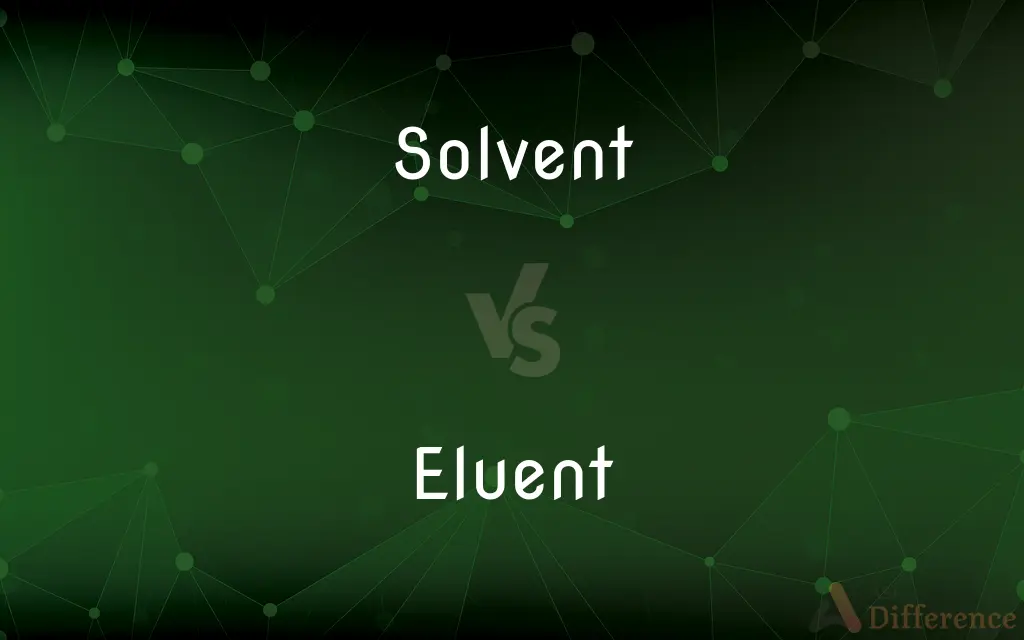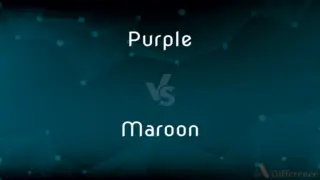Solvent vs. Eluent — What's the Difference?
Edited by Tayyaba Rehman — By Maham Liaqat — Updated on April 24, 2024
Solvent refers to any substance capable of dissolving another to form a solution, commonly used in various chemical processes, whereas eluent is specifically the liquid used in chromatography to carry the material to be separated.

Difference Between Solvent and Eluent
Table of Contents
ADVERTISEMENT
Key Differences
Solvent is a general term for any substance, usually a liquid, that can dissolve another substance, resulting in a solution. It is widely used across chemistry for various processes like cleaning, extraction, and chemical reactions. On the other hand, eluent, a term specific to chromatography, is the liquid or gas that carries the substances through the chromatograph for separation.
While solvents are involved in creating solutions in a broad range of chemical applications, from industrial solvents removing greases to solvents in pharmaceuticals aiding drug delivery, eluents play a crucial role in the analytical process of separating mixtures into their individual components. The choice of eluent is critical for the effectiveness of the chromatographic separation.
Solvents can be organic, such as ethanol and acetone, or inorganic, such as water. These substances are chosen based on their ability to dissolve various solutes. Conversely, eluents are selected based on their ability to interact with the components of the mixture and the stationary phase of the chromatography setup, optimizing the separation process.
In terms of functionality, while all eluents are solvents in the context of chromatography, not all solvents are used as eluents. Solvents may serve in a wide variety of capacities beyond carrying substances for separation, such as in chemical synthesis and materials processing, whereas eluents are specifically used to control the separation of components in chromatographic systems.
The term solvent is more familiar and broadly applicable in everyday contexts, such as in household products or industrial applications, highlighting its versatility. In contrast, the term eluent is specialized and primarily used in scientific contexts, particularly in labs and research involving chromatographic techniques.
ADVERTISEMENT
Comparison Chart
Definition
A substance capable of dissolving another substance
A fluid used in chromatography to carry the mobile phase
Usage
Broad in chemistry, industry, and daily life
Specific to chromatographic processes
Types
Organic (e.g., ethanol), inorganic (e.g., water)
Selected based on chromatographic requirements
Applications
Cleaning, extraction, synthesis
Separation of mixture components in chromatography
Context
General chemistry, industrial
Analytical chemistry, specifically chromatography
Compare with Definitions
Solvent
A liquid used to dissolve other materials.
Acetone is often used as a solvent in nail polish remover.
Eluent
The mobile phase fluid in chromatography.
A mixture of water and acetic acid can serve as an eluent in certain types of chromatography.
Solvent
Used metaphorically to describe a solution to a problem.
Dialogue is a solvent for political conflict.
Eluent
A substance that carries analytes through the chromatograph.
Methanol was used as an eluent in the separation of lipid classes.
Solvent
A substance that dissolves a solute, forming a solution.
Water is a universal solvent because it dissolves more substances than any other liquid.
Eluent
Used in laboratories to facilitate the separation of mixtures.
Gradient elution involves changing the eluent composition during the chromatography process.
Solvent
A chemical that can carry other substances in solution without chemical change.
Ethanol is a common solvent in pharmaceutical applications.
Eluent
Selected based on its ability to interact with substances and the stationary phase.
The eluent’s polarity is crucial for effective separation in HPLC.
Solvent
Any medium in which substances are dissolved.
In oil painting, turpentine is used as a solvent for the paint.
Eluent
A specific solvent chosen for its properties relative to the substances being analyzed.
Non-polar solvents like hexane are used as eluents in non-polar column chromatography.
Solvent
(Chemistry) Capable of dissolving another substance.
Eluent
A substance used as a solvent in separating materials in elution.
Solvent
A substance in which another substance is dissolved, forming a solution.
Eluent
(analytical chemistry) In chromatography, a solvent used in order to effect separation by elution.
Solvent
A solvent (from the Latin solvō, "loosen, untie, solve") is a substance that dissolves a solute, resulting in a solution. A solvent is usually a liquid but can also be a solid, a gas, or a supercritical fluid.
Solvent
Capable of meeting financial obligations.
Solvent
A substance, usually a liquid, capable of dissolving another substance.
Solvent
Something that solves or explains.
Solvent
A fluid that dissolves a solid, liquid, or gaseous solute, resulting in a solution.
Solvent
That which resolves.
Solvent
(finance) Able to pay all debts as they become due, and having no more liabilities than assets.
Solvent
Having the power of dissolving; causing solution.
Solvent
Having the power of dissolving; dissolving; as, a solvent fluid.
Solvent
Able or sufficient to pay all just debts; as, a solvent merchant; the estate is solvent.
Solvent
A substance (usually liquid) suitable for, or employed in, solution, or in dissolving something; as, water is the appropriate solvent of most salts, alcohol of resins, ether of fats, and mercury or acids of metals, etc.
Solvent
That which resolves; as, a solvent of mystery.
Solvent
A liquid substance capable of dissolving other substances;
The solvent does not change its state in forming a solution
Solvent
A statement that solves a problem or explains how to solve the problem;
They were trying to find a peaceful solution
The answers were in the back of the book
He computed the result to four decimal places
Solvent
Capable of meeting financial obligations
Common Curiosities
Can any liquid be a solvent?
While many liquids can act as solvents, they must be able to dissolve other materials to be classified as such.
What is the primary use of an eluent?
The primary use of an eluent is to facilitate the separation of components in a chromatographic process.
What is the main function of a solvent?
The main function of a solvent is to dissolve other substances to form a solution.
Are all solvents used as eluents?
Not all solvents are used as eluents; eluents are specifically chosen for their effectiveness in chromatography.
What determines the choice of an eluent in chromatography?
The choice of an eluent in chromatography depends on its interaction with the mixture’s components and the stationary phase.
What role do solvents play in pharmaceuticals?
In pharmaceuticals, solvents are used to dissolve drugs for delivery in a suitable medium.
Why is the polarity of an eluent important in chromatography?
The polarity of an eluent affects how substances interact with the stationary phase, influencing separation efficiency.
How does the solvent function in paint?
In paint, the solvent dissolves the binder and pigments, allowing the paint to be spread evenly before evaporating.
How do solvents and eluents differ in application?
Solvents have broad applications across various fields, whereas eluents are specifically used in chromatography for separating mixtures.
How does the choice of eluent affect chromatographic resolution?
The choice of eluent directly affects the resolution of the chromatographic process by altering how substances separate.
Can eluents be gases?
Yes, eluents in gas chromatography are gases, such as helium or nitrogen.
Is water always an effective solvent?
Water is a very effective solvent for many substances but not all; some require organic solvents.
What are some safety concerns with using solvents?
Many solvents are volatile and can be flammable or toxic, requiring careful handling and adequate ventilation.
What is gradient elution in chromatography?
Gradient elution involves gradually varying the composition of the eluent during the chromatographic process to improve separation.
Can the same solvent be used for different applications?
Yes, the same solvent can often be used for different purposes, depending on its chemical properties.
Share Your Discovery

Previous Comparison
Tiny vs. Minute
Next Comparison
Purple vs. MaroonAuthor Spotlight
Written by
Maham LiaqatEdited by
Tayyaba RehmanTayyaba Rehman is a distinguished writer, currently serving as a primary contributor to askdifference.com. As a researcher in semantics and etymology, Tayyaba's passion for the complexity of languages and their distinctions has found a perfect home on the platform. Tayyaba delves into the intricacies of language, distinguishing between commonly confused words and phrases, thereby providing clarity for readers worldwide.














































